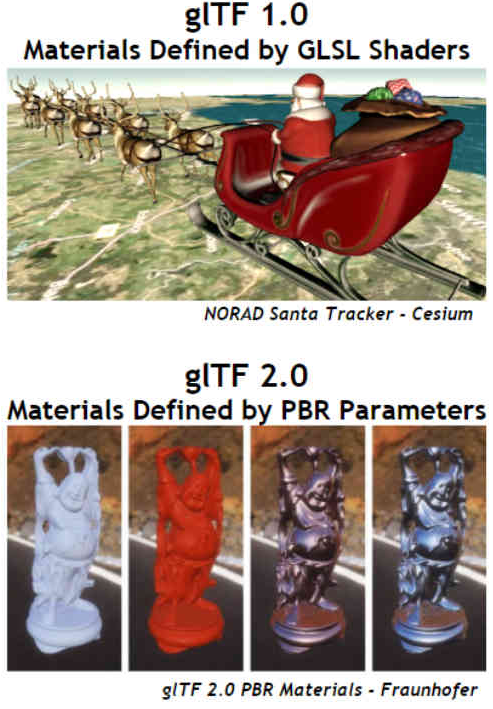Version 2.0 of the popular standard will make it easier to share lush visual assets with full fidelity, yet keep runtime processing time to a minimum.
 The industry standard specifications for run-time delivery of 3D assets just got little more efficient with the release of glTF 2.0 this week. The update introduces Physically Based Rendering (PBR), allowing for portable, consistent description of materials.
The industry standard specifications for run-time delivery of 3D assets just got little more efficient with the release of glTF 2.0 this week. The update introduces Physically Based Rendering (PBR), allowing for portable, consistent description of materials.
The royalty-free specification from The Khronos Group provides an open specification for efficient transmission and loading of 3D scenes and models by software products. Software products using glTF can minimize both the size of 3D assets and the runtime processing required to manipulate and display them. The specification defines a common publishing format for software developers, allowing 3D content tools and services to streamline processes and increase interoperability.
 A Khronos Group representative says the addition of PBR was in response to “major functionality requests from the developer community.” In glTF 1.0, a material was defined with a GLSL shader, which suited WebGL, but was problematic when importing a glTF model into a Direct3D or Metal application. By using PBR, visually arresting glTF 2.0 models are now consistently portable to any rendering API.
A Khronos Group representative says the addition of PBR was in response to “major functionality requests from the developer community.” In glTF 1.0, a material was defined with a GLSL shader, which suited WebGL, but was problematic when importing a glTF model into a Direct3D or Metal application. By using PBR, visually arresting glTF 2.0 models are now consistently portable to any rendering API.
A PBR material is defined by a few concise parameters that can be used to generate shaders for any rendering API. Khronos says glTF 2.0 defines “a simple to implement, but powerful, PBR model” that provides high-quality materials, and is scalable to suit the capabilities of different classes of platform and device.
Khronos Group says many engine developers have already started transitioning to glTF 2.0, including BabylonJS, three.js, Cesium, Sketchfab, and teh xeogl and instant3Dhub engines. glTF 2.0 is also seeing industry support by companies such as Adobe, Google, Marmoset, Microsoft, Nvidia, Oculus, UX3D, and others as well as research universities University of Pennsylvania and Sapienza University of Rome.
An ecosystem of tools and sample codes including several glTF 2.0 sample models, from simple boxes to complex models with PBR materials, skins and morph targets, are all available to help engine developers implement glTF 2.0. There is also a validation tool to let exporter developers confirm that they are generating valid glTF 2.0 models, and to let engine developers know that they are consuming valid 2.0 models.
The new specifications for glTF 2.0 can be found at GitHub.
What do we think?
Standards make the magic of computing ubiquitous. GraphicSpeak covers announcements like this because they mean next year’s AAA games or updates to your favorite graphics creation tools will run a little better and make better use of 3D assets.
An example of an object rendered at runtime using glTF 2.0 and Physically Based Rendering. (Source: Norbert Nopper)





